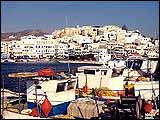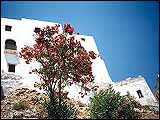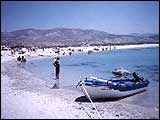|
 Naxos
is the largest of the Cycladic islands with high mountains, fertile valleys,
sandy beaches and charming villages. Naxos or “Chora” is the capital and the
port of the island, one of the most beautiful towns of the cycladic islands.
Among its many landmarks are the imposing Portara on Palatia islet, the Castle
and the famous Kouros. Don’t miss to visit the Archaeological Museum. Naxos
has a typical Mediterranean weather with summers that are hot and dry, while
winters are mild and wet. Its famous locally produced products are a various
kinds of cheeses like xynotiro, kefalotiri and athotiro, Citron liqueur and
Honey. It’s picturesque villages and beautiful beaches are worth a visit. In
the summer there are also one-day excursions to the smaller islands, Koufonisia,
Irakleia and Donousa, of the Eastern Cyclades. Naxos
is the largest of the Cycladic islands with high mountains, fertile valleys,
sandy beaches and charming villages. Naxos or “Chora” is the capital and the
port of the island, one of the most beautiful towns of the cycladic islands.
Among its many landmarks are the imposing Portara on Palatia islet, the Castle
and the famous Kouros. Don’t miss to visit the Archaeological Museum. Naxos
has a typical Mediterranean weather with summers that are hot and dry, while
winters are mild and wet. Its famous locally produced products are a various
kinds of cheeses like xynotiro, kefalotiri and athotiro, Citron liqueur and
Honey. It’s picturesque villages and beautiful beaches are worth a visit. In
the summer there are also one-day excursions to the smaller islands, Koufonisia,
Irakleia and Donousa, of the Eastern Cyclades.
Chora 
Is the islands port and capital, a typical Cycladic town with narrow streets and
classical cycladic cubed houses. Chora is built on a hillside to the northwest
side of the island. It looks impressive with its Venetian castle at the upper
part of the town, the most romantic location from where to enjoy the  sunset.
Interesting monuments are to be found all over the town like Byzantine churches,
the castle itself and traces of Mycenaean building, as well as the
Archaeological museum with Mycenaean pottery and Cycladic figurines and Portara
a huge portal of the unfinished temple of Apollo, which you should visit. The
Chora of Naxos is a very lively town. Most of the people walk up and down the
waterfront where numerous bars, discos, café, taverns, restaurants, souvenir
shops and boutiques are concentrated. sunset.
Interesting monuments are to be found all over the town like Byzantine churches,
the castle itself and traces of Mycenaean building, as well as the
Archaeological museum with Mycenaean pottery and Cycladic figurines and Portara
a huge portal of the unfinished temple of Apollo, which you should visit. The
Chora of Naxos is a very lively town. Most of the people walk up and down the
waterfront where numerous bars, discos, café, taverns, restaurants, souvenir
shops and boutiques are concentrated.
Villages

Apiranthos: Apiranthos is 27
Kilometres from Naxos town and one of the most beautiful village of Naxos island
situated on Zas Mountain. Panagia Apeiranthitissa, at Apiranthos, is one of the
oldest and remarkable churches with some excellent post Byzantine icons.
Apollon: A fishing village situated on
a bay sheltered by high mountains, at the north of the island. Its tourist
development was due to the famous kouros and the crystal clear water of the
beach carrying the same name.
Filoti: Filoti is build at the lower
slops of Za Mountain. The plane-tree (Platanos) in the village’s central
square is an ideal spot for the visitor to enjoy a cup of coffee or a
traditional Greek meal at the taverns around the square. The village church
dated 1801, Our Lady Filotissa, is one of the island's finest.
Archaeological Museum

It includes exhibits from the early Cycladic period, containing marble vessels,
fine decorated earthenware pots, tools made of wood, stone and copper and
Cycladic statues famous for their simplicity of expression. The Mycenaean
collection with exhibits mainly from the excavations at Grotta, such as pots of
differing shapes, funeral gifts made of gold, cameos and assorted small
ornaments and exhibits from the Geometric, Classical, Hellenistic and Roman
period.
Portara 
 Portara
is the entrance to the uncompleted Temple of Apollo. Portara is of 6 meters
height and 3,5 meters width and It is built on Palatia islet. Archaeologists
believe that the building of the temple had stop when war broke out between
Naxos and Samos and thereafter it remained unfinished. Portara
is the entrance to the uncompleted Temple of Apollo. Portara is of 6 meters
height and 3,5 meters width and It is built on Palatia islet. Archaeologists
believe that the building of the temple had stop when war broke out between
Naxos and Samos and thereafter it remained unfinished.
Castle of Naxos 
The Castle of Naxos and the border tower (Tower of Glezos) protecting the
fortress are situated at Chora. The Glezos tower has four levels and it is the
only tower in Naxos that has a round tower attached to it. The Venetian Markos
II Sanoudow built the fortress of Chora in Naxos with circuit towers, one of
which, the Glezos tower is still preserved. The tower has been given to the
Archaeological service, which plans to use it as a museum.
Beaches 
 Agios
Prokopios: It stretches for many kilometres along the southwest coast of
Naxos and is considered to be one of the most beautiful of the island. The water
is crystal clear and the sand is gold and due to its position protected from the
north winds. Bars and restaurants are available just by the seashore. Agia
Anna: Another long and golden sandy beach actually to the right of Agios
Prokopios beach with the same characteristics. Plaka: The continuation of
the Agia Anna and Agios Prokopios beaches. Plaka is famous for its white sand.
On the seashore there are many taverns with exceptional food Apollon: A
small sandy bay in the village and a wide pebble beach near by. Coffee shops,
taverns, snack bars, “ouzeri” and souvenir shops are available in a walk
distance from the beach. Apollon village main attraction is the crystal clear
waters and the kouros. Mikri Vigla: Fine white sand, one of the best in
Naxos Psili Ammos: Golden sandy beach and crystal clear water, with
natural cliff shadow. Pyrgaki: Fine golden sandy beach combined with the
natural beauty of inland. Agios
Prokopios: It stretches for many kilometres along the southwest coast of
Naxos and is considered to be one of the most beautiful of the island. The water
is crystal clear and the sand is gold and due to its position protected from the
north winds. Bars and restaurants are available just by the seashore. Agia
Anna: Another long and golden sandy beach actually to the right of Agios
Prokopios beach with the same characteristics. Plaka: The continuation of
the Agia Anna and Agios Prokopios beaches. Plaka is famous for its white sand.
On the seashore there are many taverns with exceptional food Apollon: A
small sandy bay in the village and a wide pebble beach near by. Coffee shops,
taverns, snack bars, “ouzeri” and souvenir shops are available in a walk
distance from the beach. Apollon village main attraction is the crystal clear
waters and the kouros. Mikri Vigla: Fine white sand, one of the best in
Naxos Psili Ammos: Golden sandy beach and crystal clear water, with
natural cliff shadow. Pyrgaki: Fine golden sandy beach combined with the
natural beauty of inland.
How to get there

By air: from the Eleutherios Venizelos airport of
Athens By ferry: from Piraeus and from Rafina port
|